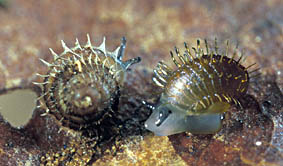 *
revealing also: fascinating convergences in shell shape and
radula morphology
*
revealing also: fascinating convergences in shell shape and
radula morphologyHelicinidae Costa Rican Helicinids New Species
The Land Snail Family Helicinidae
The Helicinidae represent a family of very remarkable land snails which is -due to its distribution limits- nearly unknown in Europe. However, they comprise over 500 described species that occur in roughly equal portions both in the tropical and subtropical zones of the New World as well as of indopacific and pacific islands including margins of the Asian and Australian continents. The name "Helicinidae" immediately reminds most people of "Helicidae", the most popular group of land snails including e. g. Helix pomatia, but the important two letters "ni" only from the Latin dimunitive of the latter name alluding to superficial similarities of otherwise completely different things. In fact, Helicinidae and Helicidae are at least as distinct from each other as fishes from human beings.
The Helicinidae represent a group of gastropods that - in an evolutionary sense - was the first to evolve to terrestrial life independently from any other and usually better known group of land snails, e. g. the pulmonates. Their closest relatives are found among the marine and freshwater inhabiting Neritopsines. In tropical environments they often contribute a significant portion to the molluscan fauna both in diversity and abundance. Despite those points of interests they were mainly neglected as objects of research.
The last comprehensive revision of the group dates back to A. J.
WAGNER (1907-1911) only being followed by scattered papers on restricted areas and the
systematic approaches by H. B. BAKER.
Major topics of my interest and research on the Helicinidae include:
* Review of characters with respect to their applicability on species distinction and higher systematics
* Phylogenetic analysis
* Biogeographical questions (e. g. in the Caribbean and on Pacific Islands)
* Population studies and questions of the diversification
 *
revealing also: fascinating convergences in shell shape and
radula morphology
*
revealing also: fascinating convergences in shell shape and
radula morphology
* Revision of the Costa Rican Helicinidae
* Revision of the New Caledonian Helicinidae
* Revision of the Helicinidae of the Lesser Antilles
* including also: discovery and description of new species
Biogeographical Questions (e. g. in the Caribbean and on Pacific Islands)
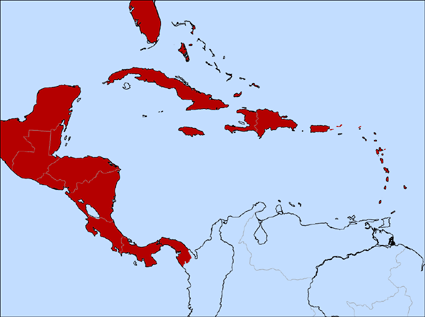
Distribution of Helicina in Central America (not
considering South America!)
Convergences in Shell Shape and Radula Morphology
In Helicinidae numerous striking examples of similar shell shapes can be found for species living in the same habitat. The same applies to radula features when species scratch their food (probably mainly surface covering algae) on similarly hard or soft surfaces (e. g. leaves versus rocks). The exaple given below shows an "Old World" species, Geophorus agglutinans from the Philippine Islands and the "New World" species Priotrochatella josephinae from Jamaica. Both live and feed on moss covered calcareous rocks. The shell is flattened and when living the bright yellow shell is contrasted by the nearly black body resulting in a final appearance of a greenish-whitish dotted shell which is perfectly camouflaged in its habitat. The edges of the radula teeth are hardened and lack any cusps that are differenciated in species rasping their food from soft surfaces.
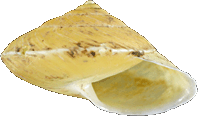

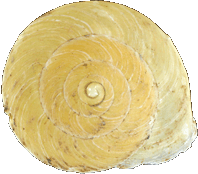

Shells of Geophorus agglutinans (left) and Priotrochatella
josephinae (right)
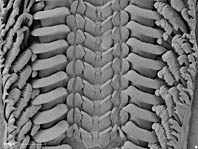
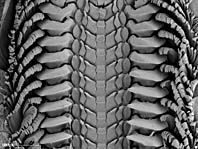
SEM photographs of radulas of Geophorus agglutinans
(left) and Priotrochatella josephinae (right)
Revision of the New Caledonian Helicinidae
 For New Caledonia more than 30 species of
Helicinidae were described up to now. The real diversity seem to amount a little more than
half of this number of species, but a few taxa had not yet been described. One striking
(and frustrating) feature of the New Caledonian Helicinidae is that most of them look
roughly the same or very similar, at least at a first glance. This might explain to some
extend the number of synonyms created in the past and the difficulties to approach this
fauna.
For New Caledonia more than 30 species of
Helicinidae were described up to now. The real diversity seem to amount a little more than
half of this number of species, but a few taxa had not yet been described. One striking
(and frustrating) feature of the New Caledonian Helicinidae is that most of them look
roughly the same or very similar, at least at a first glance. This might explain to some
extend the number of synonyms created in the past and the difficulties to approach this
fauna.
A revision of the New Caledonian species is finally published (RICHLING 2009). It is based on very comprehensive collections made by the staff of the Malacology of the Muséum National d'Histoire Naturelle de Paris (mainly Philippe BOUCHET and Simon TILLIER) in the 70s and 80s. The project was carried out in a close cooperation with the MNHN, Paris.
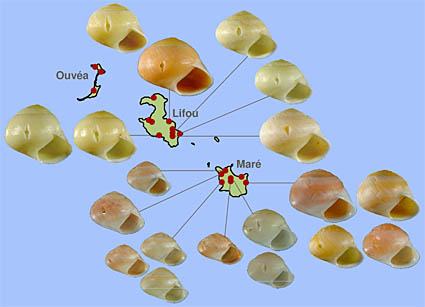
Variation of Sturanya sphaeroidea on the Loyalty
Islands Lifou and Maré
Revision of the Helicinidae of the Lesser Antilles
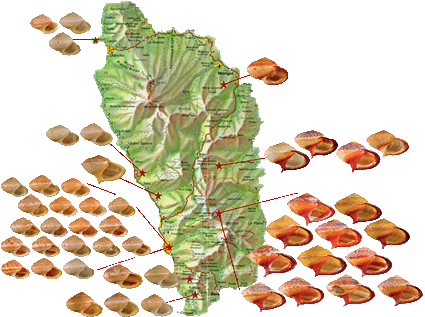
Variation of the endemic Helicina rhodostoma on
Dominica
The Lesser Antilles harbour a diversity of very pretty, shiny coloured helicinids. By this colouration the species are perfectly camoulaged for an arboreal life style on and under leaves of shrubs, palms and trees. One of the most beautiful Helicinids of the area is Helicina rhodostoma already described by GRAY in 1824. It is easy distinguished by the unusual basal spine.
Besides a still wanting alpha-taxonomical revision of the Lesser Antillean species questions about the real generic affinities arise from the former confusion of the genera Helicina and Alcadia (see also RICHLING 2004a). This leads directly to the difficult biogeographical discussions in that area that still suffer from a lack of data from really thoroughly studied groups of organisms, especially among the invertebrates.
© Ira Richling, Germany